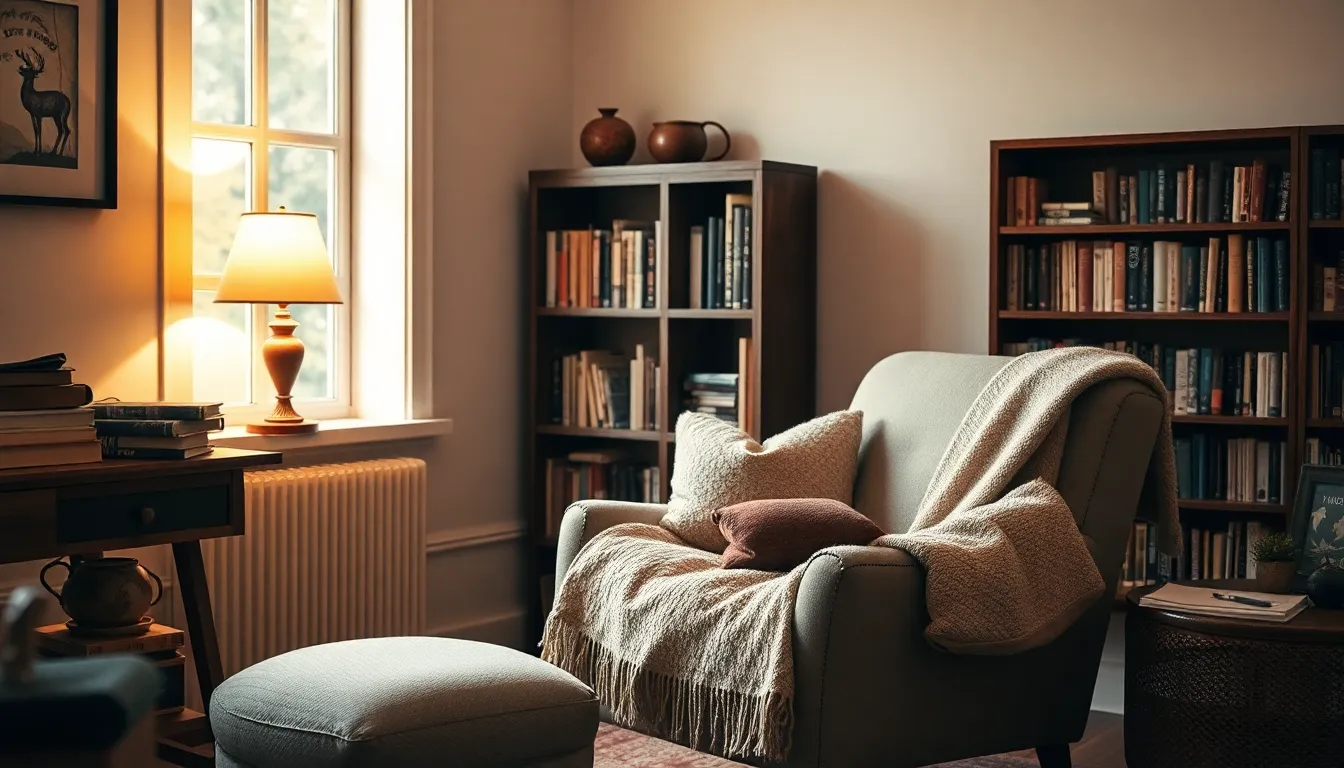Table of Contents
ToggleImagine curling up with a great book in a cozy nook, surrounded by the perfect ambiance. The right reading environment can transform a simple story into an unforgettable adventure. Whether it’s the soft glow of a reading lamp or the gentle rustle of leaves outside, the setting plays a crucial role in how stories come alive.
What Is a Reading Environment
A reading environment refers to the physical and emotional surroundings that enhance the experience of reading. Components like lighting, furniture, and sound contribute significantly to this atmosphere. Good lighting creates an inviting space, enabling readers to engage deeply without straining their eyes. Soft, ambient lighting often encourages relaxation, while a well-placed lamp can draw attention to the book.
Comfortable seating plays a crucial role as well. Cozy chairs or cushions allow individuals to settle in for extended periods, making it easier to immerse themselves in a story. A designated reading nook fosters focus, helping readers disconnect from distractions.
Natural sounds, such as gentle rain or rustling leaves, can enhance the experience further. These sounds create a backdrop that complements the storyline, drawing individuals into the narrative. Some readers might prefer silence, while others enjoy a subtle auditory landscape; personal preference often dictates what works best.
Temperature also impacts the reading environment. Ideal conditions ensure that readers feel comfortable, allowing them to concentrate on the text. Too hot or too cold can disrupt focus, diverting attention away from the narrative.
Lastly, minimizing clutter allows for a clear mind. An organized space reduces distractions, enabling a stronger connection to the book. Overall, a tailored reading environment encompasses various elements, each contributing to the overall reading experience. Emphasizing these components fosters a deeper connection to literature, enhancing enjoyment and engagement.
Importance of a Good Reading Environment

A suitable reading environment significantly enhances the experience of engaging with text. Elements like lighting, sound, and comfort play critical roles in shaping this atmosphere.
Impact on Focus and Concentration
Focus thrives in a conducive reading environment. Optimal lighting reduces eye strain, allowing readers to concentrate for extended periods. Comfortable seating invites longer engagement with the material. Less clutter minimizes distractions, helping maintain attention. A soothing background sound can also support concentration, providing a gentle audio backdrop that enhances focus.
Influence on Comprehension and Retention
Understanding material improves in a well-designed reading space. Comfortable surroundings make it easier to absorb information, leading to better retention. A cozy atmosphere encourages readers to immerse themselves in the narrative, enhancing comprehension of key themes and ideas. Similarly, the right temperature promotes comfort, preventing discomfort from detracting from mental engagement. With these components aligned, readers are more likely to remember and connect with what they read.
Elements of an Ideal Reading Environment
Creating an ideal reading environment involves various elements that enhance the experience. Consider the following aspects.
Lighting Conditions
Optimal lighting significantly affects reading enjoyment. Bright but soft lighting invites readers to engage deeply with the text. Natural light serves as the best option, reducing eye strain and creating an inviting atmosphere. Adjustable lamps offer flexibility for different times of day. Dim lighting may hinder concentration, leading to fatigue. A balance between brightness and comfort is essential for prolonged reading sessions.
Noise Levels
Noise levels play a critical role in maintaining focus. Quiet spaces promote concentration and minimize distractions. Natural sounds, like gentle rain or rustling leaves, can enhance the experience. While some prefer complete silence, others thrive with subtle background noise. A sound machine or soft instrumental music provides a comforting audio backdrop. Identifying personal preferences helps create the most conducive reading space.
Comfort and Ergonomics
Comfort and ergonomics are paramount to enjoyable reading. Proper seating supports the body, allowing for long periods of engagement. A chair with good back support fosters relaxation and reduces discomfort. Pillows and throws can enhance coziness, creating a snug environment. Positioning reading materials at eye level prevents strain and encourages longer sessions. The right combination of comfort elements encourages deep immersion in the narrative.
Tips to Enhance Your Reading Environment
Creating an ideal reading environment maximizes enjoyment and immersion. Consider the following strategies to refine your space.
Creating a Distraction-Free Zone
Establish a designated reading area to foster concentration. Silence mobile phones and other devices to eliminate interruptions. Choose a quiet location away from high-traffic areas to maintain focus. Utilize curtains or room dividers to block out noise from other spaces. Organizing books and materials neatly can reduce visual distractions. Keeping the area clutter-free invites sustained engagement with the reading material. Customize the space to suit personal preferences, including valuable adjustments for lighting and arrangement.
Incorporating Comfort Accessories
Enhancing comfort boosts the reading experience. Investing in supportive cushions or throws can greatly increase coziness during long reading sessions. Adjustable seating options promote good posture and prevent fatigue. Adding a small side table provides easy access to beverages or snacks, maintaining comfort without disrupting focus. Maintaining an optimal temperature ensures a pleasant atmosphere. Personalized decor, like favorite artwork or plants, can create an inviting ambiance. Optimizing these simple accessories transforms ordinary spaces into relaxing reading havens.
Creating an ideal reading environment is essential for enhancing the overall experience of literature. By focusing on elements like lighting comfort and sound readers can transform their spaces into inviting havens. A well-designed area not only reduces distractions but also fosters deeper engagement and comprehension.
Incorporating personal touches and maintaining organization can further elevate this experience. Ultimately a thoughtful reading environment encourages individuals to immerse themselves in stories connecting with themes and ideas on a profound level. Investing time in crafting this space pays off in the joy and understanding derived from every book.







